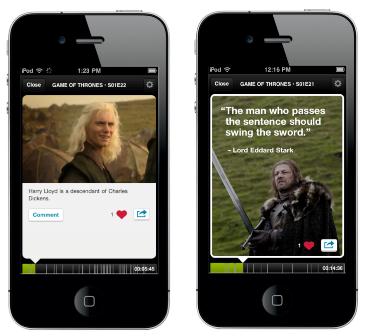There was once a time when watching television involved only one screen. Now, it seems for many viewers, one screen just isn’t enough.
According to a recent report produced by Deloitte for the Media Guardian Edinburgh International Television Festival, 24 per cent of respondents claimed to use a second screen– generally a smartphone, laptop or a tablet – while watching television.
The most active ‘second screeners’ were young people aged between 16 and 24, with almost half using communication tools such as messaging, email, Facebook, or Twitter, or emerging dedicated apps such as Miso or GetGlue, to discuss what they were watching on TV.
The rise of this so-called social TV phenomenon has caught the attention of Australian broadcasters, which have been rushing apps to market to capitalise on our desire for distraction.
According to the executive director for PricewaterhouseCoopers Australian Entertainment & Media Outlook, Megan Brownlow, the networks have some advantage through their ownership of program digital rights.
“There’s an opportunity to provide a richer, more immersive experience on that second screen if you’ve also got the content brand rights in that environment,” she says.
Earlier this year the US channel HBO broke new ground when it used Miso’s SideShow platform to allow Game of Thrones’ fans to create their own SideShow content for each episode of the first season, ahead of the premiere of the second season. Users could vote on their favourite SideShow content, with the winners awarded Game of Thrones merchandise.
But Brownlow questions whether there is a genuine business model in the second screen. After all, if networks say they know watchers are turning to their second screens during ad breaks, that acknowledges that the ads aren’t being watched on the main screen.
Today the capabilities of second screen apps are rudimentary. The most established Australian app is Fango, which was launched by Yahoo!7 in November 2011 to complement programs on the Seven Network.
The Fango app is available for both Apple and Android-based devices, and has been downloaded more than 500,000 times, while a desktop version is used by 220,000 consumers per month. The app lets users ‘check in’ to their favourite programs on any free-to-air network and chat with other viewers, vote in real time polls and collect points, as well as gain access to exclusive content such as ‘sneak peaks’.
According to Yahoo!7’s head of TV, Kristen Carlos, Fango was developed as a means of tapping into social conversations around TV shows and combating audience fragmentation across other social media apps. She says the best audience response has occurred during the Australian Open tennis and the My Kitchen Rules reality series, when tens of thousands of users were logging in.
“That idea of putting the social conversation in one place was a really big driver for us,” Carlos says. “Where we are heading with Fango is the ‘gamification’ of television, and getting people to compete with each other to be the number one fan. The other side that we are trying to push is the loyalty piece, and rewarding people.”
The company has delivered several marketing opportunities through Fango, such as sponsorship of trivia contests and polls. A longer term goal is for Fango to synchronise second screen content with the television broadcast, using technology similar to the Shazam music identification app.
In July, rival ninemsn launched its own social TV second screen app, Jump In, to support content on the Nine Network.
The director of product innovation for Mi9 (which oversees ninemsn) Rebecca Haagsma says Jump In is helping ninemsn break away from its traditional model of delivering content onto just PCs.
“When we look at our data we know a lot of our users are engaging with our content on mobile devices, and when we look at our TV-based content there is an even stronger peak on tablet and mobile devices,” she says.
Haagsma sees Jump In as a means for audiences to directly influence content, such as through gathering votes on the challenges set for the contestants on recently-revived reality show Big Brother.
But she says ninemsn is yet to engage in any form of commercialisation of the service.
“We wanted to launch the product and understand what our users are doing and how they are using it, and we want to use that data to build the right kind of advertising proposal.”
The final social TV offering to come to market, from Network Ten, is based on the US-developed ZeeBox application.
The network’s chief operating officer Jon Marquard sees the same social engagement opportunities for Zeebox as with the other apps, but believes there is potential to use it for greater engagement between content producers and the network’s audience.
At a recent SPAA Holding Redlich Business Class conducted in Melbourne, Marquard received interest from producers in how they could utilise the second screen.
“Smaller producers sometimes build shows and then don’t feel that those shows necessarily get an online, digital voice,” Marquand says. “What Zeebox provides is a way for anybody to interact with that show. So it is feasible to work with the network to put together some other assets in a Zeebox environment that augment that further and amplify what is on screen.”
The app itself has been scheduled for release before the end of September.
“Once we get it up and show people the power of what we can do, then hopefully people who are far more creative then me will come up with ideas of what they can do with Zeebox.”
This article first appeared in the IF print edition #149


